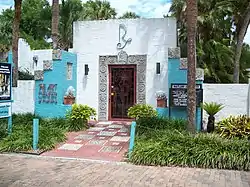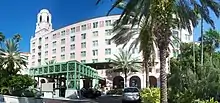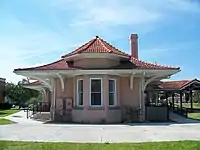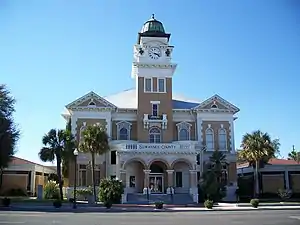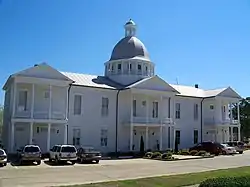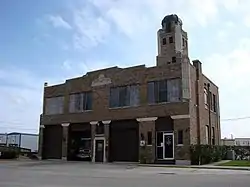
There are more than 1,800 properties and districts listed on the National Register of Historic Places in Florida. They are distributed through 66 of the state's 67 counties. Of these, 42 are National Historic Landmarks.
This National Park Service list is complete through NPS recent listings posted January 12, 2024.[1]
| Alachua - Baker - Bay - Bradford - Brevard - Broward - Calhoun - Charlotte - Citrus - Clay - Collier - Columbia - DeSoto - Dixie - Duval - Escambia - Flagler - Franklin - Gadsden - Gilchrist - Glades - Gulf - Hamilton - Hardee - Hendry - Hernando - Highlands - Hillsborough (Tampa) - Holmes - Indian River - Jackson - Jefferson - Lafayette - Lake - Lee - Leon - Levy - Liberty - Madison - Manatee - Marion - Martin - Miami-Dade (Miami) - Monroe - Nassau - Okaloosa - Okeechobee - Orange - Osceola - Palm Beach - Pasco - Pinellas - Polk - Putnam - St. Johns - St. Lucie - Santa Rosa - Sarasota - Seminole - Sumter - Suwannee - Taylor - Union - Volusia - Wakulla - Walton - Washington |
Numbers of listings by county
The following are approximate tallies of current listings in Florida on the National Register of Historic Places. These counts are based on entries in the National Register Information Database as of April 20, 2018[2] and new weekly listings posted since then on the National Register of Historic Places website.[3] There are frequent additions to the listings and occasional delistings and the counts here are not official. Also, the counts in this table exclude boundary increase and decrease listings which modify the area covered by an existing property or district and that have a separate National Register reference number.
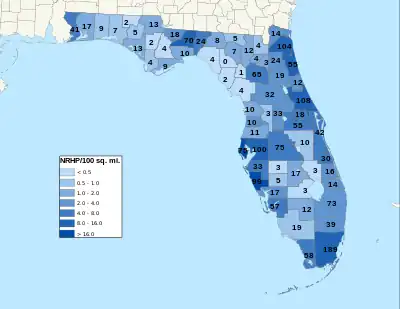
| County | # of Sites |
# of NHLs | |
|---|---|---|---|
| 1 | Alachua | 67 | 2 |
| 2 | Baker | 4 | 0 |
| 3 | Bay | 13 | 1 |
| 4 | Bradford | 3 | 0 |
| 5 | Brevard | 43 | 2 |
| 6 | Broward | 40 | 0 |
| 7 | Calhoun | 2 | 0 |
| 8 | Charlotte | 17 | 0 |
| 9 | Citrus | 10 | 1 |
| 10 | Clay | 24 | 0 |
| 11 | Collier | 19 | 0 |
| 12 | Columbia | 12 | 0 |
| 13 | DeSoto | 5 | 0 |
| 14 | Dixie | 2 | 0 |
| 15 | Duval | 109 | 2 |
| 16 | Escambia | 42 | 3 |
| 17 | Flagler | 12 | 0 |
| 18 | Franklin | 9 | 1 |
| 19 | Gadsden | 18 | 0 |
| 20 | Gilchrist | 1 | 0 |
| 21 | Glades | 3 | 0 |
| 22 | Gulf | 4 | 0 |
| 23 | Hamilton | 5 | 0 |
| 24 | Hardee | 3 | 0 |
| 25 | Hendry | 12 | 0 |
| 26 | Hernando | 10 | 0 |
| 27 | Highlands | 17 | 0 |
| 28.1 | Hillsborough: Tampa | 79 | 3 |
| 28.2 | Hillsborough: Other | 22 | 0 |
| 28.3 | Hillsborough: Total | 100 | 3 |
| 29 | Holmes | 2 | 0 |
| 30 | Indian River | 32 | 1 |
| 31 | Jackson | 13 | 0 |
| 32 | Jefferson | 24 | 0 |
| 33 | Lafayette | 0 | 0 |
| 34 | Lake | 33 | 0 |
| 35 | Lee | 58 | 0 |
| 36 | Leon | 71 | 1 |
| 37 | Levy | 4 | 0 |
| 38 | Liberty | 4 | 0 |
| 39 | Madison | 8 | 0 |
| 40 | Manatee | 33 | 0 |
| 41 | Marion | 33 | 1 |
| 42 | Martin | 14 | 0 |
| 43.1 | Miami-Dade: Miami | 79 | 5 |
| 43.2 | Miami-Dade: Other | 116 | 1 |
| 43.3 | Miami-Dade: Duplicates | 2[4] | 0 |
| 43.4 | Miami-Dade: Total | 193 | 6 |
| 44 | Monroe | 58 | 4 |
| 45 | Nassau | 14 | 0 |
| 46 | Okaloosa | 9 | 1 |
| 47 | Okeechobee | 3 | 1 |
| 48 | Orange | 56 | 1 |
| 49 | Osceola | 11 | 0 |
| 50 | Palm Beach | 74 | 2 |
| 51 | Pasco | 11 | 0 |
| 52 | Pinellas | 76 | 1 |
| 53 | Polk | 76 | 2 |
| 54 | Putnam | 22 | 0 |
| 55 | Santa Rosa | 17 | 0 |
| 56 | Sarasota | 100 | 0 |
| 57 | Seminole | 18 | 0 |
| 54 | St. Johns | 55[5] | 6 |
| 59 | St. Lucie | 16 | 1 |
| 60 | Sumter | 3 | 1 |
| 61 | Suwannee | 7 | 0 |
| 62 | Taylor | 4 | 0 |
| 63 | Union | 4 | 0 |
| 64 | Volusia | 109 | 2 |
| 65 | Wakulla | 11 | 1 |
| 66 | Walton | 7 | 0 |
| 67 | Washington | 5 | 0 |
| (duplicates) | (2)[6] | 0 | |
| Total: | 1,889 | 47 | |
See also
- Florida Underwater Archaeological Preserve
- List of botanical gardens in Florida
- List of Florida state parks
- List of National Historic Landmarks in Florida
- List of operating lighthouses in Florida
- List of Woman's Clubhouses in Florida on the National Register of Historic Places
- National Register of Historic Places Multiple Property Submissions in Florida
- List of bridges on the National Register of Historic Places in Florida
References
- ↑ National Park Service, United States Department of the Interior, "National Register of Historic Places: Weekly List Actions", retrieved January 12, 2024.
- ↑ "National Register Information System". National Register of Historic Places. National Park Service. November 2, 2013.
- ↑ "National Register of Historic Places: Weekly List Actions". National Park Service. Retrieved April 20, 2018.
- ↑ Venetian Causeway is split between Miami and Miami Beach, Vizcaya Museum and Gardens is split between city and county.
- ↑ The count for St. Johns County includes Florida's two National Monuments.
- ↑ The following sites are listed in multiple counties: Dixie Highway-Hastings, Espanola and Bunnell Road (Flagler and St. Johns) and Melrose Historic District (Alachua and Putnam).
